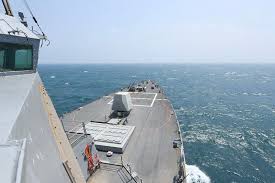BEIJING (AFP): China’s military on Friday said it had tailed and issued a warning to a US Navy ship near the Paracel Islands in the disputed South China Sea.
China “organised naval and air forces to tail and monitor the ship in accordance with laws and regulations and issued a warning to drive it away”, military spokesman Tian Junli said in a statement.
The guided-missile destroyer USS Halsey “illegally intruded into China’s territorial waters near the Xisha Islands without approval from the Chinese government”, Tian said, referring to the Paracel Islands by their Chinese name.
“The actions by the United States seriously violate China’s sovereignty and security,” he added.
Tian accused Washington of being the “creator of security risks in the South China Sea” and the “biggest destroyer” of peace and stability in the area.
In a statement, the US Navy confirmed the ship had “asserted navigational rights and freedoms in the South China Sea near the Paracel Islands”.
“At the conclusion of the operation, USS Halsey exited the excessive claim and continued operations in the South China Sea,” it added.
“Unlawful and sweeping maritime claims in the South China Sea pose a serious threat to the freedom of the seas,” the statement said.
Philippines defence chief says military must evolve fast
The Philippine military must evolve fast because of threats to a “free and open” Asia-Pacific region, Defence Secretary Gilberto Teodoro said Friday at the end of annual exercises with the United States.
Teodoro, whose comments were made against the backdrop of a festering maritime row with China, said the military must “try to focus on actual soldiering”.
“The worst thing in a kitchen is a dull knife, and a good chef hones the knife every day,” Teodoro said.
“We will be increasing the pressure continuously for them to evolve as soon as possible into a multi-threat, multi-theatre operating armed force,” he said.
The annual “Balikatan” war games, involving around 11,000 American, 5,000 Filipino and 100 Australian troops, began on April 22 and were concentrated in the northern and western parts of the archipelago nation, near the potential flashpoints of the South China Sea and Taiwan.
The area has seen increased confrontations between Chinese and Filipino vessels around shoals in the South China Sea claimed by Manila, as well as stepped-up Chinese air and naval activity around nearby self-ruled Taiwan.
Beijing claims almost the entire South China Sea despite an international ruling that its assertion has no legal basis. It deploys hundreds of coast guard, navy and other vessels to patrol the contested waters.
“No amount of malign, or for lack of a better term, perverse attempts to subvert our goal for a free and open Indo-Pacific and a rules-based international order will stop our shared advance towards upholding these internationally accepted norms come what may,” Teodoro said, using an alternative US description for the Asia-Pacific the region.
Lieutenant General Michael Cederholm, commander of the US First Marine Expeditionary Force, said the joint exercises — dubbed Balikatan, or “shoulder to shoulder” in Tagalog — “directly built warfighting readiness” for the allies.
“It should also give pause to any adversary who does not believe in a free and open Pacific, who does not believe in transparency, who does not seek peaceful resolution but would seek to use force to impose their will on other sovereign nations,” he said.
Taiwan air force holds live-fire training exercises
Taiwan’s air force conducted live-fire training exercises deploying fighter jets, missiles and laser-guided bombs, the island’s military news agency said Friday, releasing footage of the drills 10 days before the inauguration of a new president China calls a “dangerous separatist”.
Beijing claims Taiwan as part of its territory, and has refused to rule out using force to bring the island under its control.
The May 20 inauguration of incoming president Lai Ching-te will be closely watched globally, as Beijing said prior to the January vote that Lai’s election would bring “war and decline” to Taiwan.
The Taiwan Military News Agency said Friday that Taipei’s air force had conducted routine training exercises for its jet pilots “to enhance precision strike capabilities in aerial combat”, without specifying when.
Fighter jets were equipped with US-made Maverick missiles and laser-guided bombs to hit “sea and land targets at the offshore reef range near Penghu,” the agency said on its website, referring to a small collection of islands administered by Taiwan.
Footage released by the agency showed personnel loading the projectiles — which had “US Air Force” displayed on them — under the wings of the jets.
A pilot then released the missiles from the fighter jet, and the video footage showed an explosion in the waters around Penghu.
Like Lai, Taiwan’s current President Tsai Ing-wen rejects Beijing’s claim over the island.
Since she took power in 2016, her administration has boosted economic and military ties with the United States, a key partner for Taiwan and a major weapons provider.
On May 20, her deputy Lai will assume the reins of Taiwan’s presidency amid sky-high tensions between Taipei and Beijing, which maintains a military presence around Taiwan with warships, drones and planes.
Beijing has stepped up patrols in recent months around Taiwan’s outlying Kinmen islands — which are administered by Taipei but located just five kilometres (three miles) from the Chinese city of Xiamen.
On Thursday, Taipei’s coast guard sounded the alarm over a fleet of seven Chinese official ships and five coast guard ships around Kinmen, with 11 of them entering restricted waters for about 90 minutes before sailing away.
Thursday’s show of maritime force was “the fourth formation of Chinese coast guard ships sailing in Kinmen waters” in May, it said.







